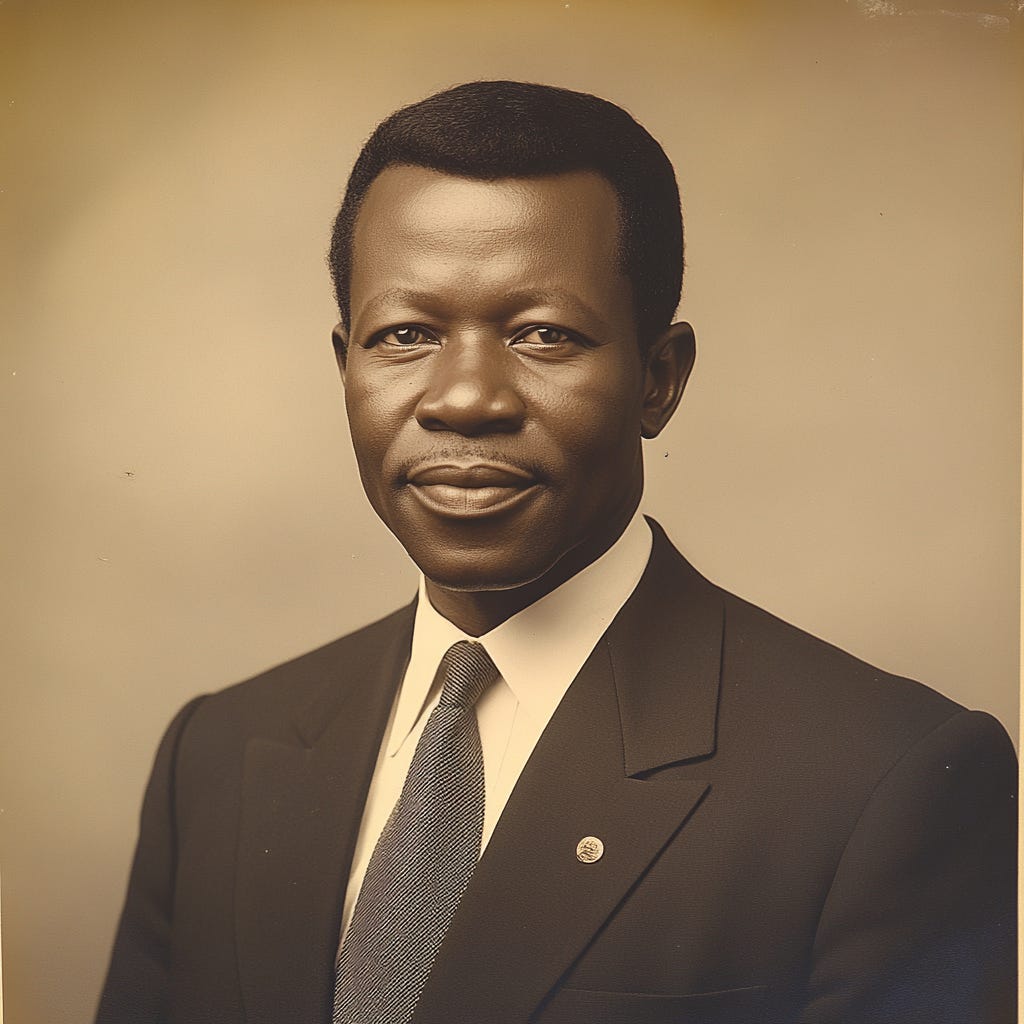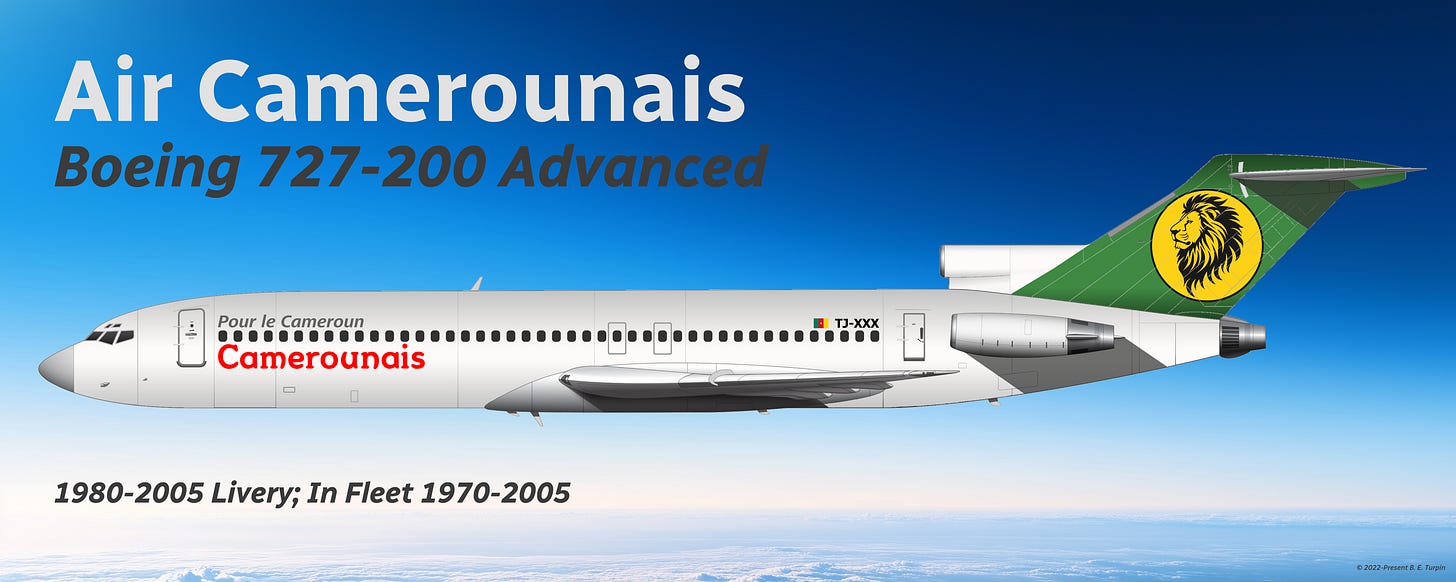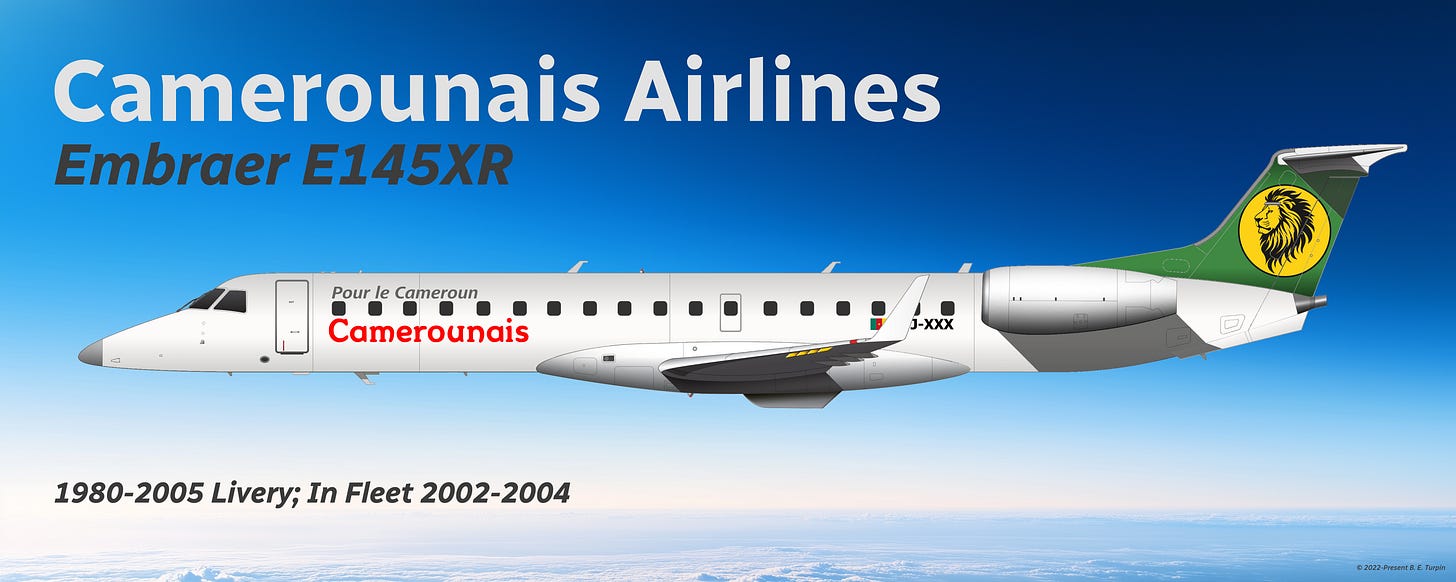Camerounais Airlines (French formal name: Société Aérienne Camerounais) is a national carrier airline for Cameroon, a country in Central Africa. Headquartered in the Immeuble La Rotonde in Douala, Cameroon, the nation’s largest city, the airline’s primary base is located at Douala International Airport (DLA). A second, smaller operating base is located at Nsimalen International Airport (NSI) in Yaoundé, Cameroon, the nation’s capital and 2nd largest city.
Established in 1960 by the Cameroon government shortly after the nation achieved its independence, Camerounais Airlines currently provides scheduled air service to 8 cities within Cameroun, 14 destinations across Africa, and nonstop service to Paris (specifically Douala-DLA «» Paris-CDG and Yaoundé-NSI «» Paris-CDG). The carrier also operates a dedicated cargo division serving several airports across central Africa. The company utilizes a mixed fleet of turboprop and jet aircraft to achieve its goals.
Originally a 100% state owned enterprise, Camerounais Airlines has been a jointly held public-private corporation since 2005.
History
1962-1966: Early Days
Société Aérienne Camerounais (SAC), later known as Camerounais Airlines, was founded in February 1960 as a state-owned airline, a few weeks after the Republic of Cameroon first emerged from France. In October 1960 the fledgling carrier purchased its first aircraft: A pair of Douglas DC-4 four-engine prop aircraft, which were acquired from a French broker.
After extensive maintenance overhauls in France before SAC finally took delivery of the DC-4s in September 1961, and also purchased a set of 4 de Havilland DHC-3 Otter prop aircraft that same month.
By January 1962 the airline renamed itself as Société Air Camerounais, and on 20 February 1962 the carrier began operating scheduled air service within Cameroon from its hub at Douala-DLA.

After acquiring three more Douglas DC-4s, the airline added its first international nonstop service in December 1962, beginning with Douala-DLA «» Dakar-DKR and DLA «» Kinshasa-FIH.
By 1965 the company acquired its first jet airliners - a pair of gently used Sud Aviation SE 210 Caravelle aircraft on lease from a French airline - and added service between DLA «» Bangui-BGF, DLA «» N'Djamena-NDJ and DLA «» Cotonou-COO.
1967-1979: A Period of Growth
During the 1960s and 1970s, Cameroon’s economy grew to become one of the most prosperous in Africa. The airline was run directly from the offices of the Cameroon Ministry of Transport until 1966, when the central government appointed Benoît Malimba to be the 1st Chairman of Société Air Camerounais, with a mandate to run the airline more or less independently.
Mr Malimba, a Cameroonian native, had worked for the now-defunct Central Africa Airlines and had a wealth of past airline leadership experience. He was given a generally free hand and a generous infusion of cash with which to purchase better quality aircraft in order to expand the airline’s route network.

Mr Malimba began by purchasing a set of new de Havilland DHC-6 Twin Otters to service smaller cities and towns across Cameroon - some of which were passenger aircraft while others were dedicated freighters. Due to their ability to land at even the most primitive airstrips, the Twin Otters soon became a regular sight across the nation.
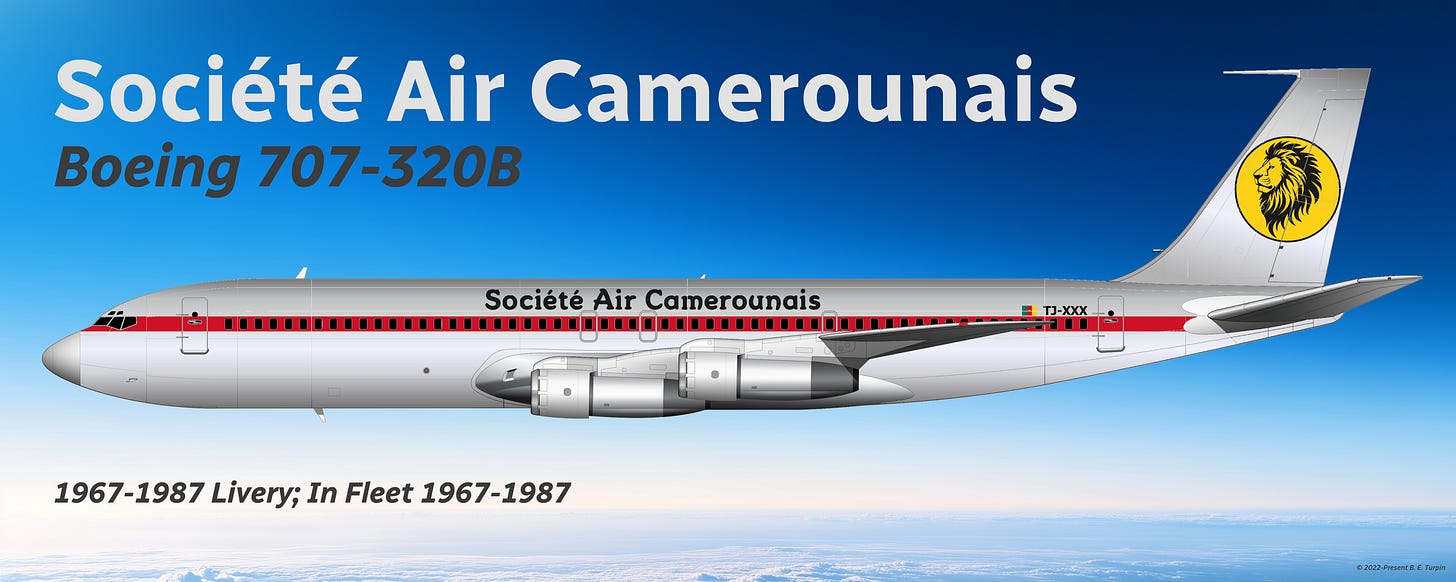
In 1967 Mr Malimba also picked up an almost-new Boeing 707-320B quadjet from a French airline entering bankruptcy at the time. He used it to start nonstop scheduled air service between Douala-DLA «» Paris-ORY 4 days a week and DLA «» London-LGW 3 days a week. Both routes proved to be profitable for the carrier, and a 2nd 707-320B was added to the fleet in 1969 that allowed the airline to upgrade DLA «» ORY and DLA «» LGW to a daily scheduled service.
In 1968 SAC purchased several used Vickers Viscount turboprop airliners to set up a 2nd base at Yaoundé-NSI, establishing further connections to numerous domestic and regional destinations across central Africa.
In 1969 the airline renamed itself to Air Camerounais. The following year the carrier acquired the first of several Boeing 727-100 and Boeing 727-200 trijets, a new generation midrange airliner to be used on several routes within Africa. The two Sud Aviation SE 210 Caravelles were retired.
Meanwhile the company’s aging Douglas DC-4s were in turn being gradually converted into dedicated freighters. The conversions, which were made locally, gave Air Camerounais the means to provide stronger scheduled and ad hoc cargo services to airports across much of Africa. By the late 1970s Douala-DLA became a bustling regional cargo hub hauling freight across wide swaths of the continent.
In 1979, Benoît Malimba left Air Camerounais to become the nation's transport minister. Mr Malimba went on to retire from public service in 1988, passing away in late 1999 at the age of 80.
1980: René N'Kono Becomes Chairman
René N'Kono was appointed as the 2nd Chairman of Air Camerounais in 1980 by his predecessor, Minister of Transport Benoît Malimba.
Never accused of being an innovator, Mr N’Kono was a rather staid but reasonably capable bureaucrat who worked hard to make sure the company at least broke even, which it usually did. Some observers conjectured that Mr. Malimba continued to manage the airline in the background, though he personally denied this.
Mr N’Kono’s three most notable contributions were 1) renaming the carrier to Camerounais Airlines, 2) rolling out a somewhat more modern looking (for the time) livery, known as the Green Tail livery, and 3) the introduction of the Boeing 747-200 jumbojet to the company’s fleet.
1981: Boeing 747-200 Service Arrives
For many years, the government of Cameroon had sought ways to create a non or direct route between Douala-DLA «» New York-JFK. The route was deemed to be both prestigious and beneficial.
Unfortunately, the carrier's Boeing 707s could not fly nonstop from central Africa to New York-JFK, and the cost of new Boeing 747 aircraft at the time was prohibitive. Initially, attempts were made to set up refueling stops for the 707s at Tenerife-TFS or Dakar-DKR, but these plans failed to come to fruition.
In 1981, the government of Cameroon purchased a used Boeing 747-200 quadjet from a recently defunct Nigerian airline. The 747 arrived at Douala-DLA in July 1981 to much fanfare, but not without its problems.
The first issue was the massive widebody aircraft required a takeoff run of 10,000–12,000 ft / 3048–3,658 m, raising questions about whether the 747 could safely use the slightly shorter runway of 9,448 ft / 2880 m at Douala-DLA. There were also concerns about whether there would be sufficient demand to fill the 366-seat plane on a regular basis. There was also the matter of the aircraft’s higher operating costs, which were three times higher than the cost to operate a Boeing 727. The government leadership didn't care about any of this, however, and told the airline to find a way to make it work.
So it was that on 3 August 1981, Camerounais Airlines began flying nonstop air service 6x weekly (except Sundays) between Douala-DLA «» New York-JFK.
Less than two weeks after the new 747 service began the quadjet, loaded to capacity, barely avoided overshooting the runway at Douala-DLA during a heavy downpour.
Airline management soon discovered that the jumbojet could safely take off from Douala-DLA, but only if it carried passengers and their luggage, and little to no freight. The 747 could easily transport both passengers and a full cargo of freight at Yaoundé-NSI, however, because of its longer runway. In October 1981 the airline began to fly four weekly passenger-only flights on the DLA «» JFK route, and three weekly passenger-and-cargo flights on the JFK «» NSI route. The airline earned enough money to break even on a quarterly basis, despite the modest passenger demand, thanks to the increased revenue from cargo shipped to and from the USA.
This seemed to please the national government, which also pleased Mr N’Kono, and it could be said that the rest of the early 1980s went fairly well for Camerounais Airlines.
1986-1994: Struggling With Years of Recession
As mentioned earlier, Cameroon had one of the most prosperous economies in Africa during the quarter of a century following its independence from France. The nation’s commodity exports - petroleum, cocoa, coffee, and cotton - helped keep the country stay in the black. But in 1986, commodity prices dropped significantly, with a particularly steep drop in the price of petroleum. This, along with an overvalued currency and less than stellar economic management, combined to plunge Cameroon into a deep, nearly decade-long recession where real per capita GDP fell by more than 60%.
Mr N'Kono was taken aback by this unexpected development and quickly discovered that he was ill-equipped to deal with it. The airline began to rapidly burn through money as business dropped off, and Mr N’Kono had to battle furiously to keep the company’s operations stable and its fleet in decent repair.
Due to rising fuel and maintenance costs, the company was soon forced to retire its two older Boeing 707 quadjets, but airline could only find a couple of older British-leased Boeing 727-200 Advanced trijets available to replace them. The 727s had an inferior range compared to the 707, so in order to keep the Douala-DLA «» Paris-ORY and Douala-DLA «» London-LGW routes open, the airline had to add refueling stopovers at Algiers-ALG and Tunis-TUN, respectively. The carrier took hits to its profits and passenger traffic numbers as a result, and started to lose market share on both routes to foreign carriers flying more capable Boeing 707s or Douglas DC-8s.
In 1987 the airline sold off its remaining de Havilland DHC-3 Otter utility prop planes. To better capitalize on the cargo market, the company also converted all of its de Havilland DHC-6 Twin Otters into dedicated freighters.
After receiving several cash infusions from the Cameroon government to keep the carrier afloat, in early 1988 Minister of Transport Benoît Malimba removed Mr N’Kono and replaced him with André Enoka, the 3rd Chairman of the company. Unfortunately, Mr Enoka did no better; in 1990 he, too, was replaced, this time by Thomas Akono, the 4th Chairman of Camerounais Airlines.
Even though Mr Akono still had to contend with severe recessionary headwinds, he was able to balance things out through a combination of targeted layoffs, labor force attrition, furloughs, and a few modest compensation reductions.
In 1990 the Douglas DC-4s were retired and a couple of the carrier’s Vickers Viscounts were converted to freighters to replace them.
In 1992, Mr. Akono was able to negotiate fifth freedom agreements with the governments of France and Spain with some assistance from the Ministry of Transport. The agreements created these new routes:
Douala-DLA «» Barcelona-BCN «» London-LGW
Yaoundé-NSI «» Barcelona-BCN «» London-LGW
Douala-DLA «» Marseille-MRS «» Paris-ORY
Yaoundé-NSI «» Marseille-MRS «» Paris-ORY
Since both locations were well-liked by customers, this modification produced greater outcomes and all four routes became reasonably profitable.
Mid 1990s: Post-Recession Recovery and Expansion to Europe
By 1995 Cameroon eventually began to emerge from its long recession, and the company was once again able to make some positive changes to its fleet.
Mr Akono received three more lightly used Boeing 727-200 Advanced trijets. One of them was used to add another fifth freedom-enabled route between Douala-DLA «» Rome-FCO «» Frankfurt-FRA. The end of apartheid in South Africa in 1995 opened up another new market for the airline, resulting in the other two 727s being placed on new routes to Johannesburg-JNB and Cape Town-CPT.
Privatization Debate
In 1996, the central government of Cameroon began debating whether or not to privatize Camerounais Airlines or turn it into a joint public-private enterprise, and if so, how to proceed.
By cutting back on the bureaucracy surrounding the airline's daily operations, officials hoped to improve the airline's profitability. At the same time, the management wanted to keep the airline viable and stable so Cameroon wouldn't have to rely on international carriers for its commercial aviation needs.
In short, the government leadership wanted to have some say in the airline’s long term plans, but also wanted leave its day to day management to industry professionals.
Several options were considered, namely:
Let the airline remain as a 100% state owned company; or
Convert the airline into a 51%-49% jointly held public-private carrier, with the government retaining a 51% share; or
Sell the airline off entirely to private investors but require that at least 51% of the airline was held by Cameroonians.
Following extensive discussion, the national leadership agreed to a fourth plan in early 1999: Sell private investors a 75% share in the airline while the government would keep the remaining 25% stake, with the government retaining the right to retake control if the carrier failed.
The Ministry of Transport also concluded that a change of leadership at the airline was also needed to help expedite the transition.
Chairwoman Joséphine Yombi

In March of 1999 Jules Lumbala, the Ministry of Transport at the time, asked Chairman Akono to retire and replaced him with Ms Nneka “Joséphine” Yombi, the 5th Chairperson of the airline.
Ms Yombi, a friendly but assertive person affectionately referred to by her employees as Mama Nneka or Miss Joséphine, came to the position from a career path that had previously taken her through both industry and government at various turns.
Joséphine Yombi began her career in 1968 at age 18 working as a stewardess with Société Air Camerounais, serving aboard its Boeing 707s and 727s. By age 25 she became a supervisor of cabin crews, and in 1979 she went along with Mr Malimba when he was promoted to Minister of Transport. By 1988 Ms Yombi had became Assistant Minister of Transport for Aviation, and in 1990 she was selected to become Minister of Transport at the age of 40.
Ms Yombi left public service in 1995 to take on a lucrative position as a top executive for Senegal-based Air Afrique, considered by many to be the most successful airline in all of Africa. In 1999, at the personal request of the President of Cameroon, Ms Yombi returned to Camerounais Airlines to become its 5th Chairman, to take charge of the company’s move towards privatization.
Her almost limitless energy, intolerance for male chauvinism, her courage and persistence in overcoming setbacks, and an unwavering dedication to and high expectations for her employees - these were all part of her brand, which she used to great effect during her 16 year tenure as Chairman.
Transition To Privatization and Fleet Revitalization
Ms Yombi requested and received an ample injection of cash from the central government to begin reorganizing Camerounais Airlines, with an eye towards achieving privatization by 2003. After first carrying out a top-to-bottom restructuring plan and implementing a series of internal reforms, she started working on revitalizing the fleet.
She started by leasing a pair of Boeing 757-200s to take over the company's routes to Europe and ordering the carrier's outdated Boeing 727-200s to be converted into Boeing 727-200CF freighters for the airline's growing cargo division.
To service several of its routes in central Africa, the firm received a series of leased Embraer E145XR aircraft, but in early 2004 Ms. Yombi made the decision to stop utilizing the airline after they encountered recurring logistical issues supporting the type.
Meanwhile, the remaining Vickers Viscount prop planes were replaced with several Bombardier Dash-8-Q200s to service the company’s domestic and regional network, while two of the Q200s were converted into pallet freighters. A number of Boeing 737-700s were also leased to service African routes. These new Q200s and 737s became the first aircraft to wear the airline’s distinctive new generation Star Tail livery.
Ms Yombi had intended to privatize the carrier by 2003, but she initially had trouble finding suitable investors. After more canvassing, she found two high quality investors willing to join in:
The Mandou Group, a Cameroonian business conglomerate led by one of the wealthiest men in Cameroon, Charles Mandou, which took a 33% stake; and
Air Afrique - her former employer - which decided to purchase a 25% share in Camerounais Airlines in return for an advantageous interlining and cooperation agreement.
With the government of Cameroon retaining its 25% share and a number of smaller Cameroonian shareholders acquiring the outstanding 17% stake, Camerounais Airlines formally became a joint public-private venture on 1 January 2005.
2005-2020: Post-Privatization Expansion
Once Camerounais Airlines finally became a joint public-private company in early 2005, Ms Yombi embarked on further efforts to refresh the airline’s fleet and expand its route network.
First, she sought and received approval from the new Board of Directors to sell off the airline’s Boeing 747-200 and replace it with four new, leased Boeing 767-300ERs. There was some pushback from a few board members, who perceived this move as reducing the prestige of the company and/or the nation. But after having some extended discussions with the President of Cameroon, Ms Yombi managed to obtain the necessary approvals.
The first two 767s that were delivered later in 2005, thereby bringing daily nonstop service to New York-JFK from both Douala-DLA and Yaoundé-NSI. After its last voyage, the 747 was given a retirement party before being sold off at a profit to an American cargo airline.
In March 2006, the company took delivery of some additional leased Boeing 737-700s and retired the last of its 727-200 Advanced passenger aircraft. A few weeks later the third leased 767 arrived and was assigned to the Douala-DLA «» Paris-ORY route, while one of the Boeing 757-200s was reassigned to fly a new route between Yaoundé-NSI «» Paris-ORY. The airline's profitability and passenger volume both increased as a result of these adjustments.
The 4th and final 767 arrived in early 2007 and was assigned to serve a new route from Douala-DLA «» Toronto-YYZ. The carrier also leased an almost new Boeing 757 to open a new DLA «» Brussels-BRU route.
In 2008 the airline introduced its new Bombardier DHC-8-Q400 aircraft, which were put to use in both passenger and cargo operations on certain higher demand domestic and regional routes.
In 2010 the central government purchased a new Boeing 767-300ER and refurbished one of Camerounais Airlines’ Boeing 757-200, both to serve as official aircraft for the President of Cameroon and his cabinet ministers. These aircraft were manned by Cameroon Air Force pilots while Camerounais Airlines maintained them and provided the requisite cabin crew and necessary hospitality services.
At the end of 2015, Ms Yombi retired as the Chairman of Camerounais Airlines after 16 years of service, receiving a resounding sendoff by her employees. Ms Yombi spends much of her time at her beachfront home in Kribi, Cameroon, but also serves occasionally as a consultant to the President of Cameroon and/or Camerounais Airlines regarding commercial aviation matters.
Charles Zambo Era
A long time protege of Ms Yombi’s, Charles Zambo, succeeded her to become the airline’s 6th and current Chairman of Cameronais Airlines in January 2016. Other than making a few tweaks here and there, Mr Zambo mostly maintained the course set by his predecessor, Joséphine Yombi.
In 2018 Air Afrique sold off its remaining 25% stake to Laurent Akono, an Cameroon-born serial entrepreneur who made much of his fortune in France. Later that year, the airline switched its Parisian destination from Paris-ORY to the more efficient and prestigious Paris-CDG.
In 2019 Mr Zambo received board approval to lease several Airbus A321LRs, with plans to convert the company’s Boeing 757s into Boeing 757-200SF Freighters, the first of which was done in early 2020.
2020s and Covid-19
The Covid-19 pandemic came to Cameroon in March 2020, having many of the same negative impacts seen elsewhere. Nearly all international travel ceased, forcing Camerounais Airlines to remove all of its Boeing 767 aircraft save for the one reserved for Cameroon’s President. All routes leading out of Africa were dropped, and most of the airline’s aircraft were put into storage, mainly at Bamenda-BPC. Meanwhile, the chairman of major stakeholder Mandou Group, Charles Mandou, died in early 2021 from Covid-19; he was succeeded by his son Jean Mandou.
Despite the slowdown in passenger traffic, the airline’s cargo division remained active throughout Cameroon and central Africa, bringing in much needed medicines and later vaccines from Europe. While the Cameroonian government had to provide some funding to help sustain the airline’s work, overall the airline held up better than it did during the 1986-1994 recession period.
Recent Aria Aircraft Acquisitions



In 2022, Camerounais Airlines ordered several new Aria T42 Transonic, Aria T102 Transonic, and Aria V42qc VTOL QC Combi aircraft, with the intention of retiring the company’s Boeing 737-700 and Bombardier Dash 8 turboprop fleets.
The carrier began converting its Boeing 757s into freighters as planned in July 2022 after it received the first Airbus A321LRs, which resumed the nonstop service to Paris-CDG.
Looking Ahead
As of press time, Camerounais Airlines has set forth plans to regrow its route network following the turbulence of the early 2020s.
These plans include a return to London-LGW and Brussels-BRU, as well as possible route expansions to destinations such as Brazzaville-BZV, Dubai-DXB, Harare-HRE, Marseille-MRS, Milan-MXP.
At the same time the airline’s incoming Aria T42 Transonic and Aria T102 Transonic aircraft are entering service on international routes across Africa, while the new Aria V42qc VTOL QC Combi is being deployed in domestic air service. More Aria V42qc aircraft have been ordered in order to connect the most remote towns in Cameroon to the route network.
Mr. Zambo is set to retire at the end of 2024. The Board of Directors recently selected Jessika Bakari, a 45-year-old senior vice president and a fellow protégé of the since-retired Joséphine Yombi, to succeed him as Chairman of Camerounais Airlines.
Destinations
Camerounais Airlines flies to the following destinations from Douala-DLA and/or Yaoundé-NSI.
Abidjan-ABJ, Côte d'Ivoire (Ivory Coast)
Addis Ababa-ADD, Ethiopia
Bafoussam-BFX, Cameroon
Bamenda-BPC, Cameroon - Aircraft Storage Facility
Bangui-BGF, Central African Republic
Cotonou-COO, Benin
Dakar-DKR, Senegal
Douala-DLA, Cameroon - Primary Hub [ Hub Map Link ]
Garoua-GOU, Cameroon
Foumban-FOM, Cameroon
Johannesburg-JNB, South Africa
Kinshasa, FIH, Democratic Republic of the Congo
Lagos-LOS, Nigeria
Libreville-LBV, Gabon
Lomé-LFW, Togo
Malabo-SSG, Equatorial Guinea
Maroua, MVR, Cameroon
Nairobi-NBO, Kenya
N'Djamena-NDJ, Chad
Ngaoundéré-NGE, Cameroon
Paris-CDG, France
Pointe-Noire-PNR, Republic of the Congo
Yaoundé-NSI, Cameroon - Secondary Hub [ Hub Map Link ]
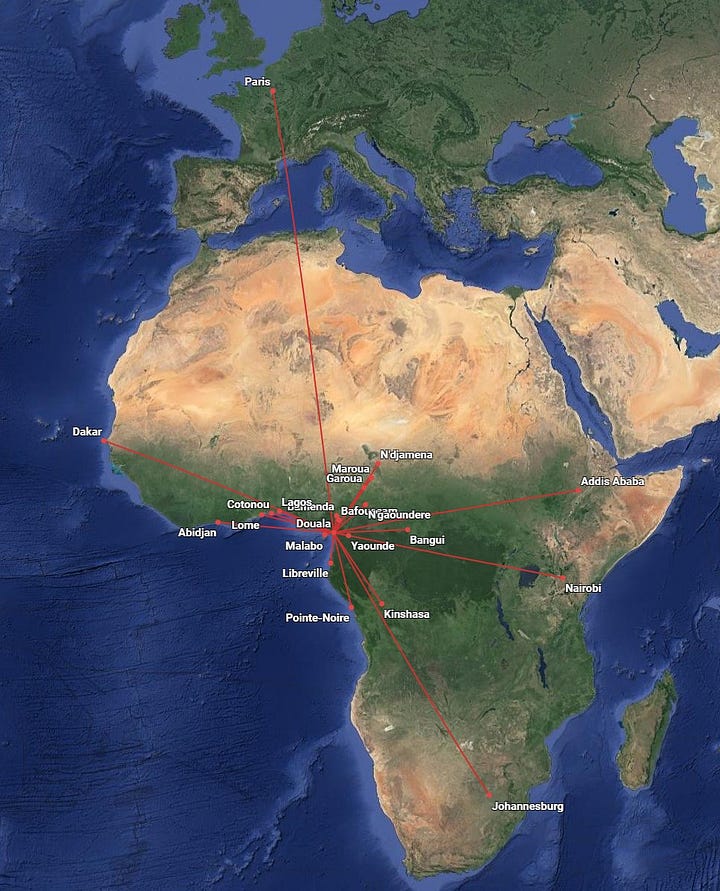
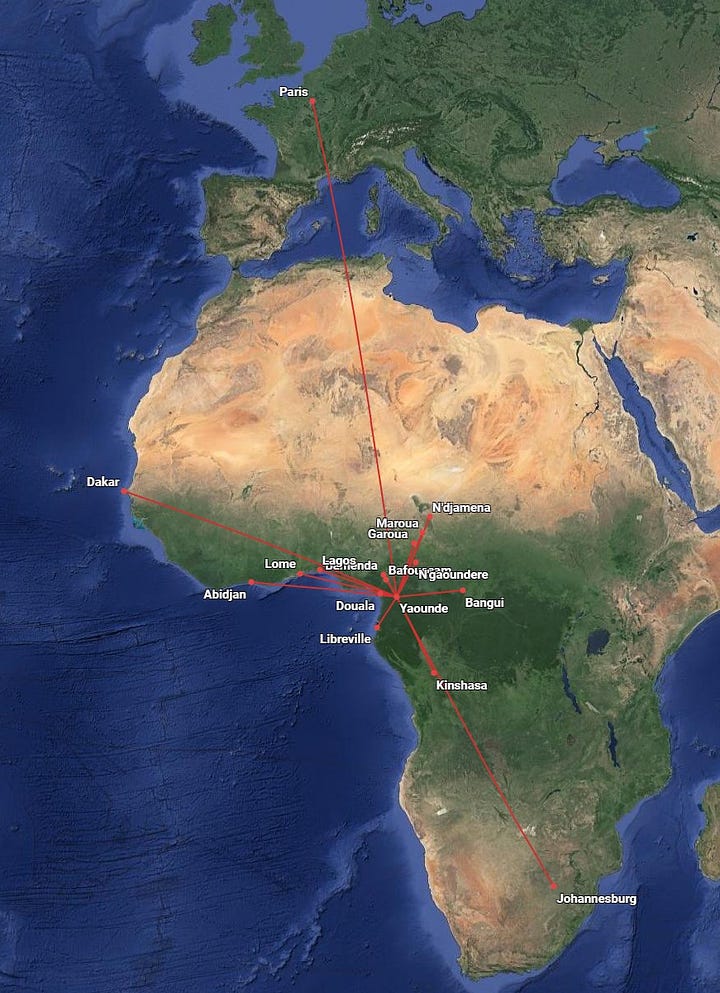
Fleet
Current Fleet
The Camerounais Airlines fleet includes the following aircraft types.
† = JStream original aircraft
Airbus A321neo - 2024-Present
Aria T42 Transonic - 2024-Present †
Aria T102 Transonic - 2024-Present †
Aria V42c VTOL Combi - 2024-Present †
Boeing 737-700 - 2002-Present - Retiring early 2025
Boeing 757-200 - 2002-Present - Ending Pax Service late 2024
Bombardier Dash-8 Q200 - 2003-Present - Retiring 2025
Bombardier Dash-8 Q400 - 2008-Present - Retiring 2025






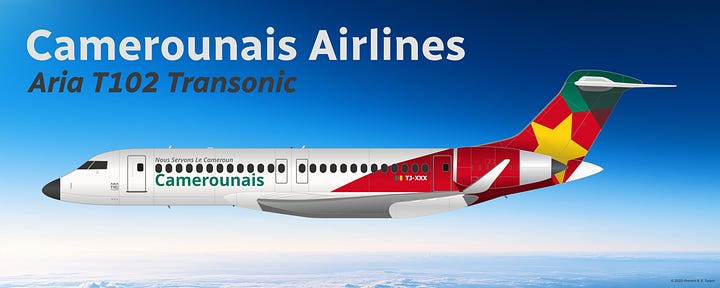

Former Fleet
Camerounais Airlines previously operated the following aircraft types.
† = JStream original aircraft
Sud Aviation SE 210 Caravelle - 1965-1970 †
Boeing 707-320B - 1967-1987
Boeing 727-100 - 1970-2005
Boeing 727-200 - 1970-2005
Boeing 747-200 - 1981-2005
Boeing 767-300ER - 2005-2020
de Havilland DHC-3 Otter - 1962-1987
de Havilland DHC-6 Twin Otter - 1967-1987 †
Douglas DC-4 - 1962-1990
Embraer E145 - 2002-2004
Vickers Viscount - 1968-1991 †








Cargo Fleet
Camerounais Airlines has operated the following aircraft types within its cargo division.
† = JStream original aircraft
Boeing 727-200CF Freighter - 1999-2023
Boeing 757-200SF Freighter - 2020-Present
Bombardier Dash-8 Q200PF Freighter - 2003-Present - Retiring 2025
Bombardier Dash-8 Q400PF Freighter - 2008-Present
de Havilland DHC-6F Twin Otter Freighter - 1987-2024 †
Douglas DC-4F Freighter - 1972-1992
Vickers Viscount (Freighter Conversion) - 1991-2004 †
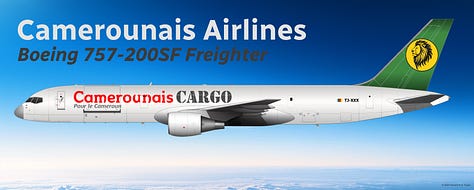


= Nota Bene =
Camerounais Airlines was inspired not by a specific airline, but rather two real life airlines: 1) the long since defunct Cameroon Airlines and 2) its current day de facto successor known as Camair-Co.
There was once a real life airline named Air Afrique (1961-2002), which IRL was based in Ivory Coast instead of Senegal. Air Afrique served multiple Francophone countries around western and central Africa in its time, and was a highly reputable carrier in its day. Unfortunately, a lengthy decline and the industry downturn following the September 11 attacks seemed to be its final death knell.
I have plans to post an article about the fictional Air Afrique at some later date.Camerounais Airlines’ modern Star Tail livery design is merely a stylized version of the country’s flag, which I think looks great on the Airbus A321 and Boeing 757, at least. I decided to let the cargo fleet keep the previous generation Green Tail livery, because cargo livery changes don’t occur as often.
The 1960s era livery is obviously retro by design, with its cheatline and the brand name’s retro-exotic looking font. The font I used is Africana Bold by Robert Petrick, which can be purchased through places like MyFonts.Com.
The 1960s era lion logo on the tail isn’t there just because lions happen to be an African thing. It’s also a salute to the Cameroon national football team, whose nickname is Les Lions Indomptables (The Indomitable Lions). I initially discovered them while they competed in the 1990 World Cup. Alongside the US team, me and a couple of friends also adopted Cameroon as our other favorite underdog team. As it happened that year Cameroon made it all the way to the quarter-finals before losing to England. I still cheer for them on to this day, and hope they make it into the 2026 World Cup so I can finally watch them play live here in North America.
I’m not at all a fan of authoritarian governments. In writing the history of this particular airline, I tried to focus more on the airline and the people running it, rather than the country’s sometimes troubled political history. I have known several expats from Cameroon through my former work career, and they were always friendly, kind and generous folk.
All liveries depicted in this article were conceived and drawn by the Author.
Aria aircraft templates displayed in this article are fictional aircraft, whose original templates were drawn by the Author.
The Sud Aviation SE 210 Caravelle, de Havilland DHC-6 Twin Otter and Vickers Viscount aircraft templates are all original, in-house created content created by the Author.
All other aircraft templates shown in this article were licensed from Norebbo and augmented by the Author for display. Blank side view templates of these aircraft are available for purchase through ShopNorebbo.
Route Maps were created using Great Circle Map.






